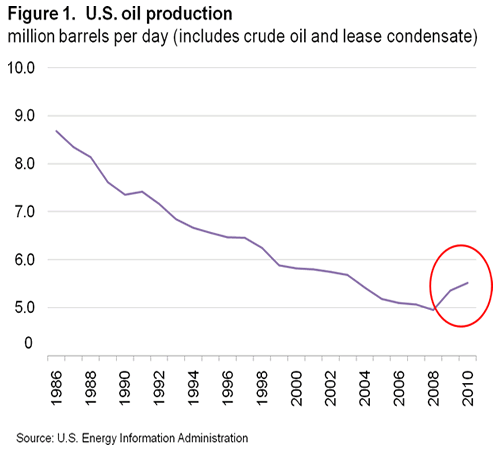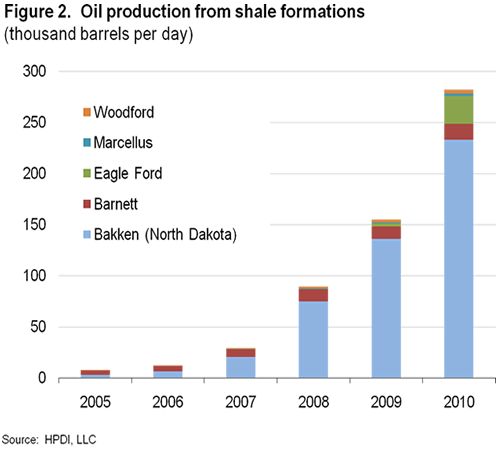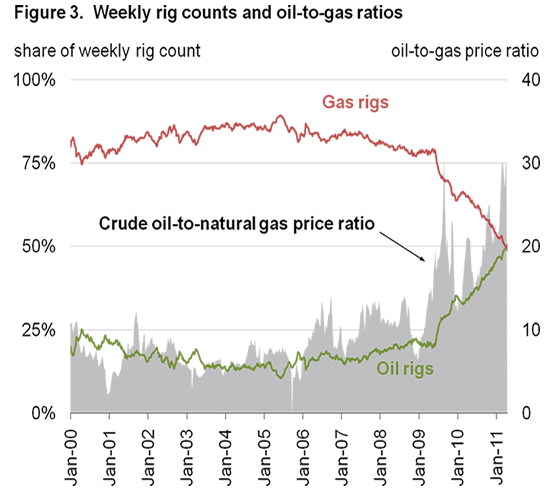Released: April 27, 2011
Next Release: May 4, 2011
Domestic oil production reversed decades-long decline in 2009 and 2010
Following declines in all but one year from 1986 to 2008, U.S. oil production (crude oil and lease condensate) increased in 2009 and again in 2010. Due in part to Hurricanes Ike and Gustav, average production dipped below 5.0 million barrels per day (bbl/d) in 2008, then climbed to 5.4 million bbl/d in 2009 and 5.5 million bbl/d in 2010, with 2010 volumes representing an 11 percent increase over 2008.

While much of the increase in 2009 was associated with deepwater developments in the Gulf of Mexico Federal Offshore, the increase in 2010 was driven primarily by escalating horizontal drilling programs at the the Bakken and other U.S. shale formations. Operators are combining horizontal wells and hydraulic fracturing-the same technologies used to significantly boost shale gas production-to do the same for oil. In North Dakota, for example, total oil production has approximately tripled since 2005 due largely to development of the Bakken (which extends into Montana and portions of Canada). Operators increased North Dakota's Bakken production from less than 3,000 bbl/d in 2005 to over 230,000 bbl/d in 2010. The Bakken's share of total North Dakota oil production rose from about 3 percent to about 75 percent over the same period.

Shale plays known primarily for natural gas production-or where horizontal drilling initially targeted natural gas-are also seeing accelerating oil-focused drilling. At the Barnett shale in Texas, overall oil production more than tripled from 2005 to 2010. Oil production from the Woodford shale in Oklahoma surpassed 4,000 bbl/d in 2010, up 42 percent from 2009 and nearly three times 2008 volumes. At the Eagle Ford shale formation in Texas, oil production, which was negligible in 2005, approached 30,000 bbl/d in 2010. Oil production from Appalachia's Marcellus shale more than doubled in 2010 from a year earlier and has grown nearly thirteen-fold since 2007.
This sharpening focus on oil developments in shale formations and other areas can be clearly seen in the significant redistribution of the Nation's rig fleet. The Baker Hughes rig count presently shows that there are more active oil-directed rigs than natural gas-directed rigs. Natural gas rigs generally accounted for between 80 and 90 percent of the total weekly rig count throughout most of the 2000s. However, starting in about mid-2009 (when the overall rig count fell to a low point after peaking in September 2008), the number of rigs targeting oil deposits has climbed significantly. The importance of horizontal drilling to increasing oil production is also underscored by the Baker Hughes rig count data. Horizontal rigs comprised less than one-third of oil-directed rigs in September 2008, and with a tripling of horizontal oil rigs since then, that share has increased to about 46 percent.

Source: U.S. Energy Information Administration based on data from Thomson Reuters.
Note: The crude oil-to-natural gas price ratio is calculated by dividing the weekly average spot price
of Brent crude oil ($/barrel) by the weekly average spot price of natural gas at the Henry Hub ($/MMBtu).
In the past, the crude oil price most utilized for this calculation was West Texas Intermediate (WTI).
Due to the significant current discount of WTI relative to Brent and other crude benchmarks, we use
the Brent price here.
One factor responsible for this shift is an increase in crude oil prices relative to natural gas prices. The ratio between the spot prices of crude oil and natural gas gauges the fuels' relative market value. The crude oil-to-natural gas price ratio, which through mid-2009 averaged over 8 from 2000 through mid-2009, has since risen considerably. The ratio (calculated by dividing the Brent spot price of crude oil in dollars per barrel by the Henry Hub spot price of natural gas in dollars per MMBtu) surpassed 30 in September 2009 and averaged close to that in March 2011. At that price ratio, oil is five times more valuable than natural gas on an energy-equivalent basis.
Retail gasoline price rises for fifth straight week while diesel price falls
The U.S. average retail price of regular gasoline increased three and a half cents from last week to $3.88 per gallon. This is $1.03 per gallon higher than last year at this time and is the highest price in April since the U.S. Energy Information Administration began tracking weekly data in 1990. The Midwest tallied the biggest price gain, more than a nickel higher than the previous week, and was followed by the East Coast where prices increased over four cents. The Rocky Mountain region registered close to a three-cent gain. West Coast prices notched up about two cents to $4.10 per gallon; it remains the only major region in the country where the gasoline price averages more than $4 per gallon. Rounding out the regions, the Gulf Coast average gasoline price was almost flat on the week.
The national average diesel price fell almost a penny this week to $4.10 per gallon. This was only the second weekly decrease since December 6, 2010. The diesel price is $1.02 per gallon higher than last year at this time. The West Coast price was down more than a penny, the biggest decline among the regions. However, diesel prices on the West Coast are still the highest in the country at $4.31 per gallon. The Gulf Coast, Midwest, and East Coast all registered decreases of less than penny on the week. The only major region to see an increase was the Rocky Mountains, where the average price was up about a penny. This is the twenty-second straight weekly increase for the region.
Propane inventories gain slightly
Total U.S. inventories of propane rose by a small margin last week, gaining roughly 0.1 million barrels to end at 26.5 million barrels total. The Midwest region accounted for the largest build of 0.3 million barrels, while the Gulf Coast region added 0.1 million barrels. The East Coast regional inventories dropped 0.3 million barrels and the Rocky Mountain/West Coast stocks were down slightly. Propylene non-fuel use inventories represented 5.9 percent of total propane inventories.
Text from the previous editions of This Week In Petroleum is accessible through a link at the top right-hand corner of this page.
 |
 |
||||||
| Retail Data | Changes From | Retail Data | Changes From | ||||
| 04/25/11 | Week | Year | 04/25/11 | Week | Year | ||
| Gasoline | 3.879 | Diesel Fuel | 4.098 | ||||
 |
 |
||||||||||||||||||||||||||
|
 |
||||||||||||||||||||||||||
| *Note: Crude Oil Price in Dollars per Barrel. | |||||||||||||||||||||||||||
 |
 |
||||||
 |
 |
||||||
| Stocks Data | Changes From | Stocks Data | Changes From | ||||
| 04/22/11 | Week | Year | 04/22/11 | Week | Year | ||
| Crude Oil | 363.1 | Distillate | 146.5 | ||||
| Gasoline | 205.6 | Propane | 26.465 | ||||